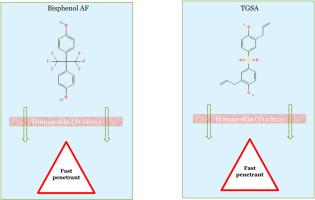Percutaneous absorption of two bisphenol a analogues, BPAF and TGSA: Novel In vitro data from human skin
IF 8.1
2区 环境科学与生态学
Q1 ENVIRONMENTAL SCIENCES
引用次数: 0
Abstract
Bisphenol AF (BPAF) and TGSA are analogues of Bisphenol A (BPA). BPAF is used in polymer synthesis, while TGSA is applied in thermal papers. The EU classifies BPAF as toxic to reproduction and TGSA as a skin sensitizer. However, TGSA's other health effects remain unclear. BPAF contamination has been noted among electronic waste workers, and TGSA exposure is documented in various professions. Despite the significance of skin contact, data on skin permeation rates for BPAF and TGSA are limited. This study aimed to generate percutaneous absorption data for BPAF and TGSA following OECD guidelines.
[14C]-labeled BPAF or TGSA was applied to human skin samples in vitro using Franz diffusion cells for 20 and 40 h, respectively. Key parameters such as steady-state flux, lag time, and skin permeability coefficient (Kp) were calculated. Furthermore, the distribution of the dose across different compartments, particularly within the skin, was evaluated at the conclusion of the experiment. Sequential strippings and epidermis-dermis separation were conducted for BPAF to predict the potential absorption of the remaining dose present within the skin.
The permeability coefficients for BPAF and TGSA were found to be 1.9 E−03 and 1.6 E−03 cm/h, with 22% and 23% of the applied doses absorbed, respectively. Both chemicals are classified as "fast" penetrants based on their Kp values. These findings suggest that BPAF and TGSA are absorbed through the skin, highlighting potential occupational risks through dermal exposure. The new percutaneous absorption data will enhance the assessment of the occupational risks.

两种双酚 A 类似物 BPAF 和 TGSA 的经皮吸收:来自人体皮肤的新体外数据。
双酚 AF(BPAF)和 TGSA 是双酚 A(BPA)的类似物。BPAF 用于聚合物合成,而 TGSA 则用于热敏纸。欧盟将双酚 AF 归类为生殖毒性物质,将 TGSA 归类为皮肤致敏物质。不过,TGSA 对健康的其他影响尚不清楚。在电子废物处理工人中发现了双酚 AF 污染,而在各种职业中都有接触 TGSA 的记录。尽管皮肤接触很重要,但有关双酚 AF 和 TGSA 皮肤渗透率的数据却很有限。本研究旨在按照经合组织(OECD)的指导方针,生成双酚 AF 和 TGSA 的经皮吸收数据。使用弗朗兹扩散细胞将[14C]标记的双酚 AF 或 TGSA 分别应用于人体皮肤样本 20 和 40 小时。计算了稳态通量、滞后时间和皮肤渗透系数(Kp)等关键参数。此外,在实验结束时,还对剂量在不同分区(尤其是皮肤内)的分布情况进行了评估。对双酚 AF 进行了顺序剥离和表皮-真皮分离,以预测皮肤内剩余剂量的潜在吸收情况。结果发现,双酚 AF 和 TGSA 的渗透系数分别为 1.9 E-03 和 1.6 E-03 cm/h,吸收率分别为 22% 和 23%。根据 Kp 值,这两种化学品都被归类为 "快速 "渗透剂。这些研究结果表明,双酚 AF 和 TGSA 可通过皮肤吸收,突出表明了皮肤接触的潜在职业风险。新的经皮吸收数据将加强对职业风险的评估。
本文章由计算机程序翻译,如有差异,请以英文原文为准。
求助全文
约1分钟内获得全文
求助全文
来源期刊

Chemosphere
环境科学-环境科学
CiteScore
15.80
自引率
8.00%
发文量
4975
审稿时长
3.4 months
期刊介绍:
Chemosphere, being an international multidisciplinary journal, is dedicated to publishing original communications and review articles on chemicals in the environment. The scope covers a wide range of topics, including the identification, quantification, behavior, fate, toxicology, treatment, and remediation of chemicals in the bio-, hydro-, litho-, and atmosphere, ensuring the broad dissemination of research in this field.
 求助内容:
求助内容: 应助结果提醒方式:
应助结果提醒方式:


